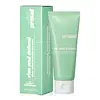What's inside
What's inside
 Key Ingredients
Key Ingredients

 Benefits
Benefits

 Concerns
Concerns

No concerns
 Ingredients Side-by-side
Ingredients Side-by-side

Water
Skin ConditioningPropanediol
SolventPolyglyceryl-4 Caprate
EmulsifyingSaccharomyces/Xylinum/Black Tea Ferment
Skin ConditioningNiacinamide
SmoothingCarbomer
Emulsion StabilisingArginine
MaskingPhenoxyethanol
Preservative1,2-Hexanediol
Skin ConditioningYeast Ferment Extract
Skin ConditioningAllantoin
Skin ConditioningBetaine
HumectantEthylhexylglycerin
Skin ConditioningDextrin
AbsorbentTheobroma Cacao Extract
Skin ConditioningSodium Hyaluronate
HumectantTocopherol
AntioxidantSalicylic Acid 2%
MaskingWater
Skin ConditioningGlycerin
HumectantSodium C14-16 Olefin Sulfonate
CleansingCocamidopropyl Hydroxysultaine
CleansingBetaine
HumectantSodium Chloride
MaskingCucumis Sativus Fruit Water
Skin ConditioningSodium Hyaluronate
HumectantCentella Asiatica Extract
CleansingMalpighia Emarginata Fruit Extract
Skin ConditioningSodium Benzoate
MaskingButylene Glycol
HumectantPotassium Sorbate
PreservativeCaprylyl Glycol
Emollient1,2-Hexanediol
Skin ConditioningSodium Hydroxide
BufferingCitric Acid
BufferingEthylhexylglycerin
Skin ConditioningPhenoxyethanol
PreservativeSalicylic Acid 2%, Water, Glycerin, Sodium C14-16 Olefin Sulfonate, Cocamidopropyl Hydroxysultaine, Betaine, Sodium Chloride, Cucumis Sativus Fruit Water, Sodium Hyaluronate, Centella Asiatica Extract, Malpighia Emarginata Fruit Extract, Sodium Benzoate, Butylene Glycol, Potassium Sorbate, Caprylyl Glycol, 1,2-Hexanediol, Sodium Hydroxide, Citric Acid, Ethylhexylglycerin, Phenoxyethanol
 Reviews
Reviews

Ingredients Explained
These ingredients are found in both products.
Ingredients higher up in an ingredient list are typically present in a larger amount.
1,2-Hexanediol is a synthetic liquid and another multi-functional powerhouse.
It is a:
- Humectant, drawing moisture into the skin
- Emollient, helping to soften skin
- Solvent, dispersing and stabilizing formulas
- Preservative booster, enhancing the antimicrobial activity of other preservatives
Betaine is a common humectant (a substance that promotes retention of moisture). It's known to be gentle on the skin and can help balance hydration.
This ingredient is best for improving hydration and soothing irritated skin. Studies also show it helps even out skin tone.
Fun fact: Betaine is naturally created in the skin and body. The kind found within cosmetic products can be either plant-derived or synthetic.
Another name for betaine is trimethylglycine.
Learn more about BetaineEthylhexylglycerin (we can't pronounce this either) is commonly used as a preservative and skin softener. It is derived from glyceryl.
You might see Ethylhexylglycerin often paired with other preservatives such as phenoxyethanol. Ethylhexylglycerin has been found to increase the effectiveness of these other preservatives.
Phenoxyethanol is a preservative that has germicide, antimicrobial, and aromatic properties. Studies show that phenoxyethanol can prevent microbial growth. By itself, it has a scent that is similar to that of a rose.
It's often used in formulations along with Caprylyl Glycol to preserve the shelf life of products.
Sodium Hyaluronate is hyaluronic acid's salt form. It is commonly derived from the sodium salt of hyaluronic acid.
Like hyaluronic acid, it is great at holding water and acts as a humectant. This makes it a great skin hydrating ingredient.
Sodium Hyaluronate is naturally occurring in our bodies and is mostly found in eye fluid and joints.
These are some other common types of Hyaluronic Acid:
Learn more about Sodium HyaluronateWater. It's the most common cosmetic ingredient of all. You'll usually see it at the top of ingredient lists, meaning that it makes up the largest part of the product.
So why is it so popular? Water most often acts as a solvent - this means that it helps dissolve other ingredients into the formulation.
You'll also recognize water as that liquid we all need to stay alive. If you see this, drink a glass of water. Stay hydrated!
Learn more about Water